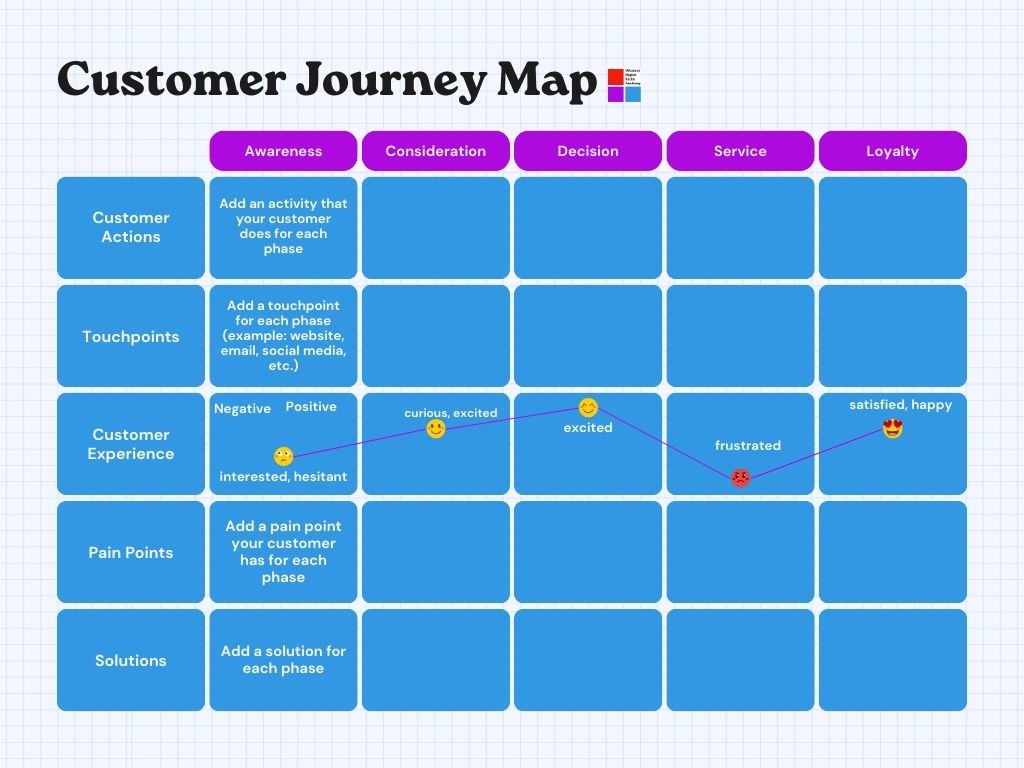What Are Customer Pain Points?
Table of Contents
Customer pain points are specific problems or challenges customers face during interactions with a product or service. These pain points occur at various customer journey stages, including awareness, consideration, purchase, and post-purchase. Addressing these pain points effectively can improve customer satisfaction, loyalty, and overall business success.
Types of Customer Pain Points
Customer pain points can be broadly categorized into four types: financial, productivity, process, and support. Understanding these categories helps businesses identify and address specific issues more effectively.
Financial Pain Points
Financial pain points involve the cost and perceived value of a product or service. Customers may feel that they are paying too much or not getting enough value for their money. Common examples include:
High Costs: A customer may find a product too expensive compared to competitors.
Hidden Fees: Unexpected charges that appear during the purchase process.
Poor ROI: A business might feel that the returns on their investment in a service are inadequate.
Example: A small business owner might feel that the subscription fees for a software service are too high and do not justify the benefits received, leading to frustration and potential churn.
Productivity Pain Points
Productivity pain points refer to issues that waste time or make processes inefficient. These pain points can significantly affect the customer’s experience and ability to achieve their goals efficiently.
Complex Interfaces: Difficult-to-navigate websites or applications.
Manual Processes: Tasks that could be automated but require manual input.
Slow Service: Delays in customer service responses or product delivery.
Example: An employee using outdated software that requires manual data entry for tasks that could be automated, resulting in wasted time and reduced productivity.
Process Pain Points
Process pain points are related to the systems and workflows customers use to achieve their goals. These issues can arise from poorly designed processes or inefficient systems.
Inconsistent Procedures: Lack of standardization in processes, leading to confusion.
Poor Communication: Miscommunications between different departments or teams.
Bureaucracy: Overly complex approval processes that slow down progress.
Example: A customer trying to return a product but facing a cumbersome return process with multiple steps and poor communication between the store and the warehouse.
Support Pain Points
Support pain points occur when customers do not receive adequate help or guidance. These pain points can significantly impact customer satisfaction and loyalty.
Unresponsive Support: Slow or no response from customer service teams.
Lack of Knowledge: Support staff lack the necessary knowledge to resolve issues.
Limited Channels: Few or inconvenient ways to contact support.
Example: A customer experiencing technical issues with a product but unable to reach support through their preferred communication channel, leading to frustration and dissatisfaction.
How to Identify Customer Pain Points
Identifying customer pain points requires a proactive approach and a variety of methods to gather insights.
Here are several effective strategies:
- Customer Surveys and Feedback
Directly asking customers for their feedback through surveys, feedback forms, and reviews can provide valuable insights into their pain points.
Surveys: Structured questionnaires that cover various aspects of the customer experience.
Feedback Forms: Simple forms that allow customers to provide feedback at any point in their journey.
Reviews: Online reviews on platforms like Google, Yelp, and product-specific forums.
Example: Send a post-purchase survey to customers asking about their shopping experience and any difficulties they encountered during the process.
- Customer Interviews
Conducting one-on-one interviews with customers can provide in-depth insights into their pain points and how they impact their overall experience.
Structured Interviews: Pre-planned questions that cover specific topics.
Open-Ended Interviews: More conversational and flexible, allowing customers to share their experiences freely.
Example: Interviewing long-term customers to understand their challenges and the areas where the business can improve its services.
- Data Analytics
Analyzing customer behavior data can reveal patterns and trends that indicate common pain points. This method involves using tools to track and analyze customer interactions.
Website Analytics: Monitoring website traffic, page views, and bounce rates.
Purchase History: Analyzing buying patterns and abandoned carts.
Customer Service Logs: Reviewing support tickets and complaint logs.
Example: Using website analytics to identify pages with high exit rates, indicating potential pain points in the user experience.
- Social Listening
Monitoring social media platforms and online communities can help identify customer pain points as they discuss their experiences publicly.
Social Media Monitoring: Tracking mentions, comments, and hashtags related to the brand.
Online Forums: Participating in or monitoring discussions in relevant forums.
Example: Analyzing social media mentions to understand common complaints or issues customers face with a product.
- Customer Journey Mapping
Creating a visual representation of the customer journey helps identify pain points at each stage. This method provides a holistic view of the customer experience and retention.
Touchpoints: Identifying all interactions customers have with the brand.
Emotional Mapping: Tracking customer emotions at each stage.
Example: Developing a customer journey map to identify stages where customers experience the most frustration or confusion.

How to Address Customer Pain Points
Once customer pain points are identified, businesses can implement strategies to address them effectively. Here are some approaches:
- Improve Product and Service Quality
Enhancing the quality of products and services is crucial in addressing financial and productivity pain points.
Quality Control: Implementing strict quality control measures to ensure products meet high standards.
Feature Enhancements: Adding or improving features based on customer feedback.
Example: Introducing new features in software to automate manual tasks, thereby improving user productivity.
- Optimize Pricing and Value
Adjusting pricing strategies and demonstrating value can address financial pain points.
Competitive Pricing: Ensuring prices are competitive within the market.
Value Proposition: Communicating the benefits and value of the product or service.
Example: Offering tiered pricing plans that cater to different customer segments, providing options that align with their budget and needs.
- Streamline Processes
Simplifying and standardizing processes can reduce process-related pain points.
Process Automation: Automating repetitive tasks to save time and reduce errors.
Standard Operating Procedures: Creating clear and consistent procedures for common tasks.
Example: Implementing an automated return process that simplifies product returns for customers.
- Enhance Customer Support
Improving the quality and accessibility of customer support can address support pain points.
Multichannel Support: Offering support through various channels, including phone, email, chat, and social media.
Training Programs: Providing regular training to support staff to ensure they have the necessary knowledge and skills.
Example: Introducing a live chat feature on the website to provide instant support to customers facing issues.
How to Integrate Customer Success Pain Points in Marketing
Integrating customer success pain points into marketing strategies can help businesses attract and retain customers by addressing their needs and concerns effectively.
- Highlight Solutions in Marketing Content
Creating marketing content that directly addresses common customer pain points can attract potential customers facing similar issues.
Blog Posts: Writing articles that provide solutions to common problems.
Case Studies: Showcasing how the product or service has resolved specific pain points for other customers.
Testimonials: Featuring customer testimonials that highlight successful problem resolution.
Example: Publishing a case study on the website showing how a business improved its efficiency by using the company’s software solution.
- Use Customer Pain Points in Messaging
Incorporating customer pain points into marketing messages can make the content more relatable and engaging.
Ad Campaigns: Creating ads that address specific pain points and offer solutions.
Email Marketing: Sending targeted emails that address common challenges and provide helpful resources.
Example: Running a social media ad campaign that addresses the high cost of traditional software and promotes a more affordable alternative offered by the company.
- Personalize Marketing Efforts
Personalizing marketing efforts based on customer pain points can enhance the relevance and effectiveness of the campaigns.
Segmented Campaigns: Dividing the audience into segments based on common pain points and tailoring messages accordingly.
Customized Offers: Providing personalized offers that address specific needs and challenges.
Example: Sending personalized email offers to customers who have expressed concerns about pricing, highlighting discounts or cost-effective solutions.
- Educate Customers
Providing educational content that helps customers overcome their pain points can build trust and position the brand as a helpful resource.
Webinars: Hosting webinars that address common challenges and offer solutions.
Guides and Tutorials: Creating detailed guides and tutorials that help customers resolve their issues.
Example: Offering a free webinar on best practices for using the company’s software to increase productivity and reduce manual work.
- Leverage Social Proof
Using social proof, such as customer reviews and success stories, can demonstrate how the product or service has resolved pain points for other customers.
Reviews and Ratings: Displaying customer reviews and ratings on the website and product pages.
Success Stories: Sharing success stories on social media and marketing materials.
Example: Featuring customer reviews that highlight how the company’s service has helped businesses save time and money.
What We Say
Understanding and addressing customer pain points is essential for businesses to enhance customer satisfaction, loyalty, and overall success. By identifying these pain points through various methods and implementing strategies to resolve them, businesses can create a more positive customer experience. Integrating customer success pain points into marketing efforts further helps attract and retain customers by showing that the business understands and cares about their needs.
Our certified Digital marketing course will teach you how to conduct customer research, provide customer service strategies, develop a customer retention strategy, and explore all the key marketing channels so you can leverage them to engage your customers and grow your business. What are you waiting for?
Follow for more digital marketing tips




